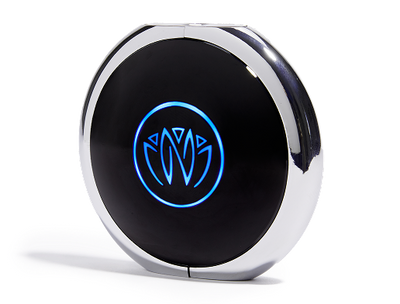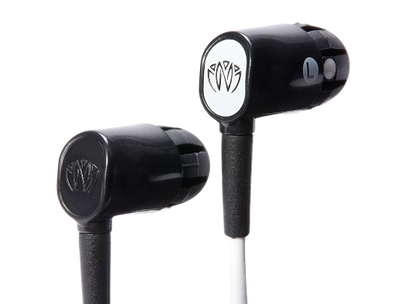9 Facts About The Vagus Nerve That You Should Know
There's a lot we still don't know about the vagus nerve, which is why it continues to be researched heavily and has the potential to change our understanding of how certain conditions function. However, there’s a lot we do know, including the nine interesting facts about the vagus nerve we will share with you today.
What is the Vagus Nerve?
Before we get to these facts, let's discuss exactly what this nerve does and which part of the body it affects.
The vagus nerve (AKA the tenth cranial nerve) is a key part of the parasympathetic nervous system (PNS). It controls various (and important!) physiological functions. It connects the brain and several organs, including the heart, lungs, and digestive tract. It is crucial for regulating the body's internal environment, homeostasis, and rest-and-digest responses.
Vagus Nerve Stimulation
Because of its connection to so many of the body's organs and systems, many people try to harness the power of the vagus nerve with what’s known as vagus nerve stimulation or VNS.
For example, vagus nerve stimulation is an FDA-approved treatment for certain types of epilepsy and depression. It has been explored as a potential treatment for conditions like migraines, fibromyalgia, autism spectrum disorder, Alzheimer's disease, and more.
VNS Methods
There are numerous ways to stimulate the vagus nerve—some of the most effective involve electrical stimulation of the vagus nerve. We'll tell you more about this option later in this post.
For now, here are six ways to stimulate the vagus nerve without electrical stimulation.
Cold water immersion and cold exposure
Cold water immersion or exposure is one of the most well-known methods of stimulating the vagus nerve. This can be done by taking a cold shower, going for a swim in cold water, or exposing yourself to cold weather conditions.
Massage
Research indicates massage may help stimulate the vagus nerve and improve HRV or heart rate variability. This suggests massage could be beneficial for those looking to reduce stress and improve their overall autonomic nervous system function.
Acupuncture
Like massage, acupuncture has also been found to stimulate the vagus nerve and increase heart rate variability. Acupuncture can activate the body's nervous system, which then has an impact on the autonomic nervous system.
Deep breathing exercises
Another way to stimulate the vagus nerve is through deep breathing exercises. With deep, diaphragmatic breaths, you can increase vagal activity while decreasing the fight-or-flight response that is associated with stress.
Sing or hum
Some research has found that singing, chanting, or humming may also stimulate the vagus nerve and have a calming effect on the body. This is said to be thanks to the vibrations created by these actions.
Yoga
Finally, yoga is another great way to stimulate the vagus nerve and reduce stress. Combining breathing exercises and poses can help promote relaxation and overall well-being.
9 Fascinating Facts About the Vagus Nerve
Now that we know a little bit more about what the vagus nerve does and why it is so integral to our health, here are nine facts you should know.
Stimulating the vagus nerve can prevent or lower inflammation
There's an interesting link between the vagus nerve and our body's inflammatory response. In fact, research suggests that the activation of this nerve can reduce inflammation in certain parts of the body, such as the joints and digestive tract. It does so by releasing anti-inflammatory molecules like acetylcholine and cytokines.
This has a number of potential benefits for those with chronic inflammatory conditions, including rheumatoid arthritis, Crohn's disease, and others.
In turn, this can help reduce pain, discomfort, and other inflammatory-related symptoms.
As this recent report explains:
"Approximately 20 years ago it was discovered that the vagus nerve regulates pro-inflammatory cytokine levels and inflammation. Subsequent research using several preclinical models revealed that vagus nerve stimulation evokes a protective decrease in pro-inflammatory cytokines in multiple inflammatory disorders. Consequently, the pro- and anti- inflammatory cytokine balance has become the predominant readout for indicating a positive outcome of vagus nerve stimulation."
The vagus nerve helps you make memories
Another interesting fact about the vagus nerve is that it plays a role in memory formation and recall. This has been demonstrated in numerous studies, suggesting that stimulating this nerve can improve memory and help with learning new skills.
The evidence suggests the vagus nerve helps activate certain areas of the brain related to memory formation and retrieval, such as the hippocampus and amygdala.
This also relates to the promising ability of VNS to help patients with certain types of memory problems, such as those caused by dementia or Alzheimer's.
It helps you breathe
There's also a strong connection between the vagus nerve and our ability to control our breathing. Specifically, this nerve helps us regulate our breathing rate and depth by sending signals to the respiratory muscles.
This is why stimulating this nerve can have an impact on respiration, as well as other physiological responses such as heart rate. To harness this effect, many people use VNS to improve their breathing and reduce the symptoms of asthma or COPD.
In fact, this 2005 study highlights the problems associated with poor vagal tone or weak vagal activity and how it can contribute to chronic obstructive pulmonary disease:
"Circumstantial evidence supports the hypothesis that the vagal nervous system is dysregulated in chronic obstructive pulmonary disease. This dysregulation can lead to an increased sensitivity of the cough reflex such that the coughing becomes, at times, "nonproductive" or inappropriate. Vagal dysregulation can also lead to an increase in the activity of the parasympathetic reflex control of the airways, which contributes to greater mucus secretion and bronchial smooth muscle contraction."
The vagus nerve controls your heart rate
Along with your respiration, the vagus nerve also helps regulate your heart rate. This is because it sends signals from the brain to the heart that can tell it how quickly or slowly you need to be beating at any given moment.
This can have an impact on how efficiently your body functions and how healthy your cardiovascular system is in general, so it's important to keep this nerve functioning properly. Athletes are particularly interested in this, as it can help them to boost their performance by controlling their heart rate and breathing.
The vagus nerve initiates relaxation after stress
Chances are, you're familiar with the fight-or-flight response. But many people need to become more familiar with the rest-and-digest response. This is the body's natural way of calming down after a stressful event, and the vagus nerve essentially controls it. While the fight-or-flight response is associated with increases in adrenaline and cortisol, the rest-and-digest response is related to a decrease in these hormones. Additionally, rather than directing resources and energy to our muscles, the rest-and-digest response helps us relax and conserve energy.
Let's explore the rest-and-digest vs. fight-or-flight responses in greater detail.
The rest-and-digest response is the body's way of calming down after a stressful event. This response is initiated by the vagus nerve and helps us to relax and conserve energy. On the other hand, the fight-or-flight response is triggered by adrenaline and cortisol, which direct resources and energy to our muscles.
When our ancestors were facing a threat (perhaps a wild animal) the fight-or-flight response would give them the energy and resources they needed to fight or flee. On the other hand, in modern times this same response can be triggered by stressors such as a tough deadline at work or an argument with a loved one. In these cases, it's often helpful to activate the rest-and-digest response so we can relax and conserve our energy.
Activating the rest-and-digest response requires activating the vagus nerve, which can be done through activities we've covered, such as deep breathing, meditation, yoga, acupuncture, massage therapy, and vagus nerve stimulation (VNS). All of these activities have been found to help reduce stress levels and promote relaxation.
The vagus nerve lets your gut "speak" to your brain
Have you ever heard of the gut-brain axis? This is the name given to the connection between our gut and brain, allowing them to communicate back and forth. This communication happens via a number of pathways, including one known as the vagal pathway. This is where your vagus nerve comes in. It helps facilitate this communication by sending signals from your gut to your brain. Then, this lets your brain know what's going on down there.
When vagal tone is strong, this communication between the brain and gut is optimized, which can help alleviate common issues like digestive problems or immune responses.
Overstimulating the vagus nerve is a common cause of fainting
As beneficial as vagus nerve stimulation can be, it's important to note over-stimulation of this nerve can have some negative effects. This is known as vasovagal syncope. It's the most common cause of fainting, and is usually caused by a sudden increase in vagal tone.
This can be triggered by a number of things. To name a few, pain, fear, or physiological stressors like exercise or low blood pressure. However, it typically causes a sudden heart rate and blood pressure drop, leading to lightheadedness and fainting.
VNS is more accessible than ever
For a long time, electrical vagus nerve stimulation was limited to being done in medical settings, often with invasive (even surgical) measures. But now, those who want to try VNS can do so with a handheld vagus nerve stimulation device like Xen by Neuvana. This involves the use of vagus nerve-stimulating headphones that plug into a handheld device. This device syncs to your phone, allowing you to control your VNS sessions with our dedicated app.
In turn, you can reap the rewards of VNS from home or wherever else you may be, without relying on invasive measures. This allows you to harness the power of neuroscience without turning to a medical professional. It also means you can easily make VNS part of your daily routine. Not to mention, it doesn't require surgery or other intensive treatments.
Vagus nerve stimulation has created a new field of medicine
It's fascinating to see what new studies and treatments will come out of VNS research. What was once thought to be a relatively obscure field of medicine is now at the forefront, with more and more people learning about the vagus nerve and its role in our bodies.
Vagus nerve stimulation has already been used to treat inflammation, anxiety, depression, epilepsy, addiction and many other conditions. As researchers continue to study this area further, we may soon find more applications for VNS therapy. There are currently a number of clinical trials underway to explore the use of VNS in different conditions, including weight loss.
VNS and its ability to impact our weight isn't necessarily a brand new concept. For example, consider what this 2014 study reports:
"Chronic inflammation as a result of immune and metabolic dysregulation is a characteristic feature in patients with obesity and is causally linked with insulin resistance and other metabolic complications. Decreased vagus nerve activity in the context of obesity has been reported. Selective cholinergic activation within the efferent vagus nerve-mediated arm of the inflammatory reflex can suppress obesity-associated inflammation and reverse metabolic complications. These findings raise the intriguing possibility that dysregulation of vagus nerve-mediated signalling might contribute to the pathogenes is of obesity and its related comorbidities."
This goes to show that there may be more to VNS and weight loss than meets the eye.
The Vagus Nerve: FAQs
We've shared some pretty incredible facts about the vagus nerve, but we know that you may still have some questions.
So here are a few FAQs to help you get to know this important part of your body:
What is the primary function of the vagus nerve?
The primary function of the vagus nerve is sending sensory information from organs in our abdomen and chest back up to the brain. This helps us maintain homeostasis and control our involuntary responses. It also helps regulate our emotions and manage stress.
What is the parasympathetic nervous system (PNS)?
The PNS is the part of the body's nervous system that helps control relaxation, digestion, and other restful activities. The vagus nerve is a significant component of this system, helping communicate signals from the brain to our organs and vice versa.
What is vagal tone?
This refers to the activity of the vagus nerve and the strength of the nerve. It measures how active or inactive your parasympathetic nervous system is, which can impact your physical and emotional well-being. For example, poor vagal tone is associated with an increased risk of inflammation, depression, and anxiety.
How does VNS work?
Vagus nerve stimulation (VNS) targets this essential nerve. Because this nerve helps control your heart rate and blood pressure, stimulating it, in turn, helps regulate mood and reduce inflammation. VNS therapy sends small electrical current pulses through electrodes placed near your neck or earlobe to stimulate the vagus nerve. This sends impulses to the brain that can help reduce anxiety, depression, and other mood disorders.
What are the benefits of VNS?
VNS therapy has been used for a wide range of medical conditions. To name a few, depression and anxiety, migraine headaches, epilepsy, addiction, tinnitus, and even obesity. It's non-invasive and highly effective in helping people manage their symptoms and improve their quality of life.
What are some common ailments that VNS can treat?
VNS is used to treat a variety of conditions including depression, anxiety, epilepsy, addiction, inflammation, and more. It is even being used for weight loss. Along with treating medical conditions, many people who try VNS at home experience mood-boosting benefits, as well as better sleep, optimized recovery, better focus, and other exciting advantages.
Do I need medical treatment for VNS?
No – with handheld vagus nerve stimulators like Xen by Neuvana, you can perform VNS therapy from home or wherever else you may be without relying on a medical professional or invasive treatments. However, if you have certain conditions, including epilepsy, surgical VNS might be an appropriate option for you. It's important to speak with your doctor if you are considering VNS.
Recap: Amazing Facts About the Vagus Nerve
These are just a few of the amazing facts about the vagus nerve everyone should know. The vagus nerve is an incredible part of our body and its potential applications are incredible. By understanding more about this critical section of the nervous system, we can unlock new doors in neuroscience. It can also be used to develop treatments that will help us lead healthier, happier lives. With handheld VNS like Xen by Neuvana, these treatments are now available to you right at home – with no medical intervention or expensive surgery required.
So, start exploring the power of VNS today and take charge of your health!





